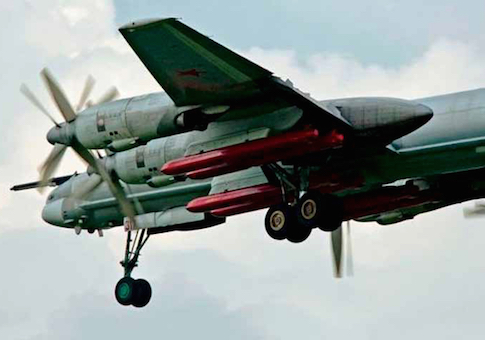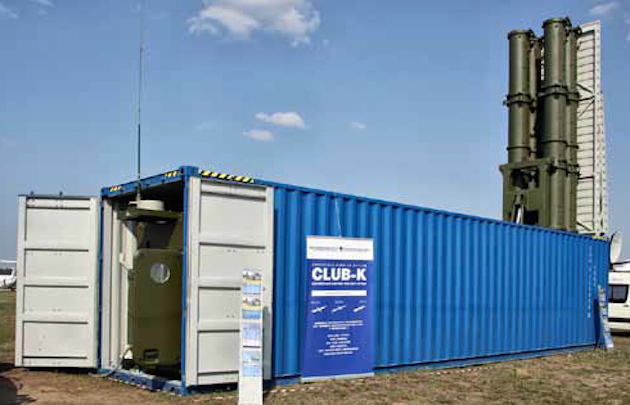
Russia is developing a long-range cruise missile that poses a new threat to the United States, the commander of the U.S. Northern Command warned this week.
“Russia is progressing toward its goal of deploying long-range, conventionally-armed cruise missiles with ever increasing stand-off launch distances on its heavy bombers, submarines, and surface combatants, augmenting the Kremlin’s toolkit of flexible deterrent options short of the nuclear threshold,” Adm. William Gortney, Northcom chief who heads the U.S.-Canadian North American Aerospace Defense Command (NORAD) said Thursday.
“Should these trends continue, over time NORAD will face increased risk in our ability to defend North America against Russian cruise missile threats,” he said in prepared testimony to the House Armed Services subcommittee on strategic forces.
A defense official said the missile that concerns the Northcom commander is the Russian KH-101 cruise missile which Russia has developed as a weapon to attack critical infrastructure in the United States, such as the electrical grid.
The comments highlight what defense officials and military analysts say is the growing threat of long-range cruise missiles.
Cruise missiles pose unique threats because they can defeat defenses by flying at low altitudes, avoiding radars, and hiding behind terrain. Some newer cruise missiles have radar-evading stealth features making them even less visible to radar or infrared detectors.
The low-flying missiles also can overwhelm defenses by attacking with multiple missiles coming from different directions and defeating air defenses at their weakest points. They also can fly circuitous routes to reach targets, avoiding radar and air defenses.
Testimony by Gortney and other senior officials at the hearing raised concerns that growing missile capabilities could overwhelm U.S. defenses.
Vice Adm. James Syring, director of the Pentagon’s Missile Defense Agency, testified that North Korea’s missile development, in particular, is a major concern. Syring said because of funding cuts he may have to advise Gortney that “the [missile defense] system is over-matched.”
Subcommittee Chairman Rep. Mike Rogers (R., Ala.) said he is very concerned about funding shortfalls for missile defense.
“The United States of America is on its way to losing its military edge, not just in terms of the ability to project power, but to even defend the homeland,” Rogers said. “This situation is intolerable.”
Gortney, in his testimony, said: “We remain concerned with the development of conventional cruise missiles that could provide near peer adversaries with options to strike the United States without the perceived risk of retaliation of a nuclear exchange.”
The threat was highlighted in early September, when two Russian Tu-95 strategic bombes conducted practice cruise missile bombing strikes on the United States from launch areas off the coast of eastern Canada, U.S. defense officials said.
Across Capitol Hill, Adm. Cecil D. Haney, commander of the U.S. Strategic Command, also voiced concerns about the growing cruise missile threat that he said is affecting U.S. defenses and deterrence.
“The concept of mating advanced weapon systems with commonplace items—such as surface-to-surface cruise missiles disguised as shipping containers—blurs the line between military and civilian environments and complicates our deterrence calculus,” Haney said in testimony to the Senate Armed Services Committee Thursday.
Haney said the Air Force is developing a new air-launched Long-Range Stand-Off nuclear cruise missile to replace the aging air-launched cruise missiles now in use. The new missile is needed to defeat sophisticated air defenses, like those that China is developing.
Neither admiral gave specific technical details on the new Russian cruise missile.
However, former Pentagon nuclear strategist Mark Schneider said the Russian missile is the KH-101.
“The Russians describe the KH-101 as a 5,000-kilometer [3,106-mile] range conventional cruise missile,” he said. “The KH-102 is the nuclear version.”
The KH-101 is configured for launch on Russian strategic bombers. There have been Russian press reports that a sea-based variant is deployed on Russia’s Severodvinsk-class nuclear attack submarines.
A report by the National Air and Space Intelligence Center (NASIC) said at least nine nations are developing land-attack cruise missiles and several will make them available to foreign customers. “The cruise missile threat to U.S. forces will increase over the next decade,” the report said.

Russia’s Club K cruise missile / National Air and Space Intelligence Center
According to NASIC, Russia’s Club-K cruise missile is sold in a “container launcher” that looks like a standard shipping container. The Club-K can launch cruise missiles from cargo ships, trains, or commercial trucks.
China also has a new long-range cruise missile called the DH-10, and Iran’s land-attack cruise missile is the 1,242-mile-range Meshkat.
The new missiles challenge U.S. dominance in the field of precision conventional cruise missiles.
“The emerging capability of near peers to generate similar long-range strike effects could complicate our decision-making,” the four-star admiral said.
To counter the cruise missile attack threat, the United States has deployed a sensor system called the Joint Land Attack Cruise Missile Defense Elevated Netted Sensor System (JLENS).
The first system was deployed at the Army’s Aberdeen Proving Ground in Maryland and a second will be deployed later this year.
Gortney said JLENS will be a key element of countering the cruise missile threat, and said his command, in charge of U.S. homeland defense, needs better intelligence on the cruise missile threat near U.S. airspace and shores.
“Whether it is a strategic bomber, a submarine, or a surface combatant, defeating the archer is technically more feasible and affordable than defeating the arrow,” he said. “The ability to locate, intercept, and if necessary destroy these platforms before they can launch a strike is crucial.”
The U.S. military is working with the Canadian military to modernize or replace sensors systems designed to detect air intrusions into U.S. and Canadian defense zones.
“Before we can engage an airborne threat, we must be able to see it,” Gortney said, adding that doing so requires developing advanced surveillance to detect, track, and monitor aircraft, cruise missiles, and drones.
“The new surveillance capabilities will, when necessary, cue our defense systems against the full spectrum of air threats of all sizes, at all altitudes, and at all speeds,” he said.
Retired Air Force Lt. Gen. Dave Deptula, a former senior intelligence official, said Gortney’s concerns are warranted.
“The threat of accurate, low observable, conventional cruise missiles requires more attention in the form of deterrent capability, systems that yield improved situational awareness, and effective defenses,” said Deptula, now dean of the Mitchell Institute of Aerospace Studies.
“These increasing threats underscore why we need build the kind of deterrent and situational awareness capabilities resident in a new long-range sensor shooter aircraft,” he said. “They also should be a wake up call for us not to neglect our northern tier bases.”
Schneider, the former Pentagon strategic nuclear policy official, said the KH-101 is one of several new cruise missiles being developed by the Russians.
“There is a very large asymmetry in cruise missile capability developing between the U.S. and Russia,” Schneider said. “We have eliminated our only nuclear submarine-launched cruise missile, are ending production of our Tomahawk conventional ship launched cruise missile and the range of our air-launched conventional cruise missile is less than 1,000 kilometers,” he said. “Our follow-on nuclear air-launched cruise missile is not until late 2020s. All of this reflects the fact that the Russians are preparing to fight us while we are preparing to fight terrorists.”
